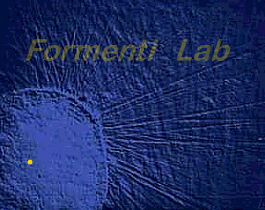


Considering the key role of calcium ions in neurosecretion, synaptic plasticity, long-term potentiation, neurotoxicity, etc. the regulation
of Ca2+ permeability may play a prominent role in all these phenomena, changing the integrative properties of neurons and regulating
output at a presynaptic level.
Neurotransmitters modulate voltage-dependent calcium channels, a major patway for Ca2+ entry into the
cell, changing the ammount of current flowing through it.
Calcium channel modulation
(left figure) Enkephalin inhibited HVA calcium currents. In all diagrams, trace C refers to control and R to recovery. (left): the
modulatory effects induced by enkephalin (Enk, 400 nM) could be partially relieved by a 30 msec conditioning pulse to +80 mV (asterisk).
The
current amplitude was almost completely restored to control levels only after washing out the drug (R). The conditioning pulse
(asterisk) was effective in completely restoring the activation time course and the same occurred in washing. A different cell is
shown on the right, subjected to a similar experimental protocol, the conditioning pulse failed to relieve the inhibitory effect of
enkephalin. (Formenti et al. 1993)
Neurotransmitters modulate voltage-dependent calcium currents through multiple mechanisms
(right figure) Dopamine (50 microM) inhibited HVA calcium currents increasing the inactivation phase in a voltage-independent manner ( Formenti et al. 1998)
Papers on Calcium-channel modulation from Formenti Lab
According to biophysical criteria, inhibitory effects can be classified into voltage-dependent (VD) and voltage-independent (VI) effects.
The VD type is relieved at a higher potential or by means of a conditioning prepulse to positive voltages, this effect being also
referred to as facilitation, whereas the VI type is not affected by different test potentials or by conditioning prepulses. Since
the VI effect is not associated with a change in current kinetics and it is present for the whole period of a test pulse, it is also
called steady-state inhibition. Conversely, the VD inhibition is frequently found in association with a slowing down of activation
kinetics. Another inhibitory effect that increase the inactivation kinetics was also observed on N and P/Q-type calcium channels subtypes.
Augmenting
modulatory effects of neurotransmitters and neuromodulators on HVA currents have also been found.
Other Papers on Calcium-Channels
- Formenti A, Arrigoni E, Mancia M. 1993. Low-voltage activated calcium channels are differently affected by nimodipine. NeuroReport
5:145-147
Some physiological hypothesis on Ca-channel modulation
- Formenti, A., E. Arrigoni, et al. (1995). Calcium influx in rat thalamic relay neurons through voltage-dependent calcium channels
is inhibited by enkephalin. Neuroscience letters 201(1): 21-24.
- Carbone, E., A. Formenti, et al. (1990). "Multiple actions of Bay K 8644 on high-threshold Ca channels in adult rat sensory neurons."
Neuroscience letters 111(3): 315-320.
- Carbone, E., F. Clementi, Formenti, A. Pollo, A. Sher, E. (1989). "Action of Ca2+ agonists/antagonists in mammalian peripheral neurons."
Cell biology international reports 13(12): 1155-1164.
- A. Formenti, E. Arrigoni, M. Mancia (1994) L’encefalina inibisce l’influsso di Ca2+ attraverso i canali del Ca2+ voltaggio-dipendenti
in neuroni sensoriali periferici e centrali di mammifero. In Neurofisiologia e Dolore a cura di G. Cruccu A. Moglia G. Sandrini. 99-106
Informativa sulla Privacy


